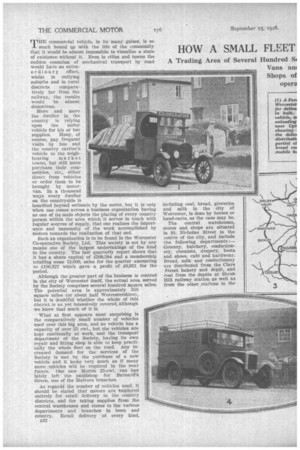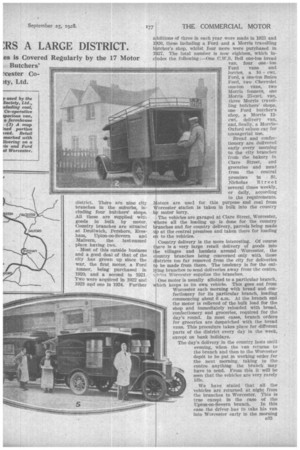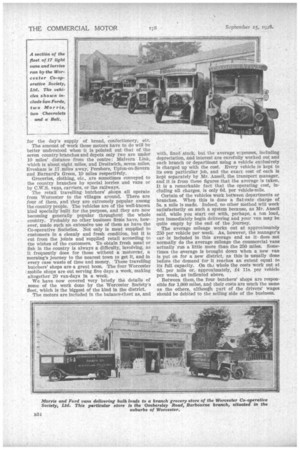HOW A SMALL FLEET IIS A LARGE DISTRICT.
Page 16

Page 17

Page 18

If you've noticed an error in this article please click here to report it so we can fix it.
A Trading Area of Several Hundred Si Vans an Shops of opera es is Covered Regularly by the 17 Motor Butchers' -cester CoAy, Ltd.
MITE commercial vehicle, in its many guises, is so -11much bound up with the life of the community that it would be almost impossible to visualize a state of existence without it. Even in cities and towns the sudden cessation of mechanical transport by road would have an extra ordinary effect, whilst in outlying suburbs and in rural
districts comparatively far from the railway, the results would be almost disastrous.
More and more the dweller in the country is relying upon the motor vehicle for his or her supplies. Many, of course, pay frequent visits by bus and the country carrier's vehicle to the neigh bouring market towns, but still more purchase their comestibles, etc., either direct from vehicles or order them to be brought by motorvan. In a thousand ways every dweller on the countryside is benefited beyond estimate by the motor, but it is only when one comes across a business organization having as one of its main objects the placing of every country person within the area which it serves in touch with regular sources of supply, that one realizes the importance and immensity of the work accomplished by motors towards the realization of that end.
Such an organization is to be found in the Worcester Co-operative Society, Ltd. This society is not by any means one of the largest undertakings of the kind in the country. The last quarterly report shows that it has a share capital of £209,584 and a membership totalling some 13,000, sales for the quarter amounting to £100,327 which gave a profit of £8,921 for the period.
Although the greater part of the business is centred In the city of Worcester itself, the actual area served by the Society comprises several hundred square miles. The potential area is approximately 350 square miles (or about half Worcestershire), but it is doubtful whether the whole of this district is as yet intensively covered, although we know that much of it is.
What at first appears most surprising is the comparatively small number of vehicles used over this big area, and no vehicle has a capacity of over 25 cwt., but the vehicles are kept continually at work, and the transport department of the Society, haying its own repair and fitting shop is able to keep practically the whole fleet on the road. Any in ' creased demand for the services of the Society is met by the purchase of a new vehicle and it looks very much as if many more vehicles will be required in the near , future. One new Morris 25-cwt. van has lately left the paintshop for Barnard's Green, one of the Malvern branches.
As regards the number of vehicles used, it should be stated that motors are employed entirely for retail delivery in the country districts, and for taking supplies from the central warehouses and stores to the various departments and branches in town and country. Retail delivery of every kind, n32 including coal, bread, groceries and milk in the city of Worcester, is done by horses or hand-carts, as the case may be.
The central warehouses, stores and shops are situated in St. Nicholas Street in the centre of the city, and include the following departments:— Grocery, butchery, confectionery, chemists, drapery, boots and shoes, café and hardwear. Bread, milk and confectionery are distributed from the Clare Street bakery and depOt, and coal from the depots at Shrub Hill railway station as well as from the other ,stations in the district. There are nine city branches in the suburbs, including four butchers' shops. All these are supplied with goods in bulk by motor. Country branches are situated at Droitwich, Pershore, Evesham, Upton-on-Severn and Malvern, the last-named place having two.
Most of this outside business and a good deal of that of the city has grown up since the war, the first motor, a Ford tomer, being purchased in 1920, and a second in 1921. Two were acquired in 1922 and 1923 and one in 1924. Further
additions of three in each year were made in 1925 and 1926, these including a Ford and a Morris travelling initcher's shop, whilst four more were purchased in 1927. The total number is now eighteen, which includes the following :—One C.W.S. Bell one-ton bread van, four one-ton Ford vans and lorries, a 10 cwt. Ford, a one-ton Baico Ford, two Chevrolet one-ton vans, two Morris tonners, one Morris 25-cwt. van, three Morris travelling butchers' shops, one Ford butcher's shop, a Morris 12cwt. delivery van, and, finally, a Morris-. Oxford saloon car for managerial use.
Bread and confectionery are delivered early every morning to the city branches froth the bakery • in Clare Street, and groceries and meat from the central premises in St. Nicholas Street several times weekly, or daily, according to the requirements. Motors are used for this purpose and coal from Viorcester station is taken in bulk into the country by motor lorry.
The vehicles are garaged at Clare Street, Worcester, where all the loading up is done for the country branches and for country delivery, parcels being made Up at the central premises and taken there for loading on to the vehicles.
Country delivery is the more interesting. Of course there is a very large retail delivery of goods into the villages and hamlets around Worcester, the country branches being concerned only with those districts too far removed from the city for deliveries to be made from there. The tendency is for the outlying branches to send deliveries away from the centre, vrhust Worcester supplies the branches.
One motor is usually allotted to a particular branch, Which keeps to its own vehicle. This goes out from Worcester each morning with bread and confectionery for its particular branch, loading commencing about 6 a.m. At the branch end the motor is relieved of the bulk load for the shop and immediately reloaded with bread, confectionery and groceries, required for the day's round. In most cases, branch orders for groceries are despatched with the bread vans. This procedure takes place for different parts of the district every day in the week, except on bank holidays.
The day's delivery in the country lasts until evening, when the van returns to the branch and then to the Worcester depot to be put in working order for the next morning, taking to the centre anything the branch may have to send. From this it will be seen that the vehicles are very rarely idle.
We have stated that all the vehicles are returned at night from the branches to Worcester. This is true except in the case of the
Upton-on-Severn branch. In this case the driver has to take his van into Worcester early in the morning 533 for the day's supply of bread, confectionery, etc.
The amount of work these motors have to do will be better understood when it is pointed out that of the seven country branches and depots only two are under 10 miles' distance from the centre: Malvern Link, which is about eight miles, and Droitwich, seven miles. Evesham is 17 miles away, Pershore, Upton-on-Severn and Barnard's Green, 10 miles respectitely. Groceries, clothing, etc., are sometimes conveyed to the country branches by special lorries and vans or by C.W.S. vans, carriers, or the railways.
The retail travelling, butchers' 'shops all operate from Worcester to the villages around. There are four of them, and they are extremely popular among the country people. The vehicles are of the well-known kind specially built for the purpose, and they are now becoming generally popular throughout the whole country. Probably no other business firths have, however, made such an extensive use of them as have the Co-operative Societies. Not only is meat supplied to customers in a cleanly and fresh condition, but it is cut from the joints and supplied retail according to the wishes of the customers. To obtain fresh meat or fish in the country is always a difficulty, involving, as it frequently does for those without a motorcar, a morning's journey to the nearest town to get it, and in every case waste of time and money. These travelling butchers' shops are a great boon. The four Worcester mobile shops are out serving five days a week, making altogether 20 van-days in a week.
We have now covered very briefly the details of some of the work done by the Worcester Society's fleet, which is the biggest of the kind in the district.
The motors are included in the balance-Pheet as, and with, fixed stock, but the average ez.penses, including depreciation, and interest are carefully worked out and each branch or department using a vehicle exclusively Is charged up with the cost. Every vehicle is kept to Its own particular job, and the exact cost of each is kept separately by Mr. Ansell, the transport manager, and it is from these figures that the average is taken. It is a remarkable fact that the operating cost, including all charges, is only 6d. per vehicle-mile.
Certain of the vehicles work between departments or branches. When this is done a flat-rate charge of 5s. a mile is made. Indeed, no other method will work satisfactorily on such a system because, as Mr. Ansell said, while you start out with, perhaps, a ton load, you immediately begin delivering and your van may be quite empty by the end of the journey.
The average mileage works out at approximately 250 per vehicle per week-. As, however, the manager's car Is included in this average and as it does not normally do the average mileage the commercial vans actually run a little more than the 250 miles. Sometimes the average is brought down when a new van is put on for a new district, as this is usually done before the demand for it reaches an extent equal to Its full capacity. On tit,: whole the costs work out at 6d. per mile or, approximately, £4 11.s, per vehicle per week, as indicated above.
Between them, the four butchers' shops are responsible for 1,000 miles, and their costs are much the same as the others, although part of the drivers' wages should be debited to the selling side of the business.
































